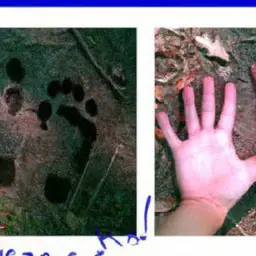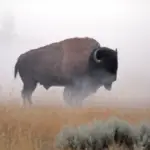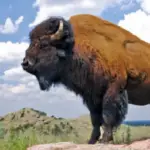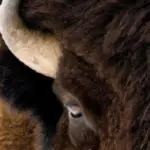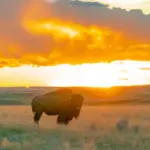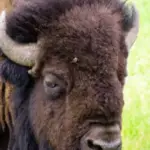Have you ever wondered just how massive a bison really is? Well, we have the answer for you! Introducing “How Big Is A Bison Compared To A Human.” This fascinating product provides you with all the juicy details about the size of a bison in comparison to a human. From its towering height to its sheer weight, you’ll be astounded by the impressive proportions of these magnificent creatures. So, if you’re curious about the scale of a bison’s dimensions, look no further than “How Big Is A Bison Compared To A Human.” It’s time to uncover the awe-inspiring truth!
Understanding the Size of a Bison
Bison, also known as American buffalo, are majestic creatures that have captured the fascination of humans for centuries. To truly appreciate their size, it is important to understand their general physical characteristics. Bison are large, hump-shouldered mammals with a stocky build. They have short, curved horns and a massive head that gives them a distinctive appearance. The average height of a bison at the shoulder can range from 5 to 6.5 feet (1.5 to 2 meters), with males being slightly larger than females. Their length can range from 7 to 11.5 feet (2.1 to 3.5 meters), and they can weigh anywhere between 900 to 2,200 pounds (400 to 1,000 kilograms).
Bison Weight and Size Comparison
When it comes to comparing the size of a bison to a human, there is a stark contrast. On average, an adult human male stands at about 5.5 to 6 feet tall (1.7 to 1.8 meters) and weighs around 150 to 200 pounds (68 to 91 kilograms). This means that a bison can easily tower over a human, both in terms of height and weight. The sheer size of a bison is truly awe-inspiring, as they can be more than four times the weight of an average human.
Bison’s Sexual Dimorphism
Sexual dimorphism, the physical differences between males and females of a species, is also evident in bison. Male bison, or bulls, are generally larger than their female counterparts, known as cows. Bulls can weigh up to 2,200 pounds (1,000 kilograms), while cows usually range around 900 to 1,400 pounds (400 to 635 kilograms). This size difference is most apparent in their shoulder hump and horns, with bulls having a more prominent hump and larger, thicker horns compared to cows.
Human Dimensions for Comparison
Now, let’s shift our focus to humans for comparison. On average, adult humans have a height range of 5.5 to 6 feet (1.7 to 1.8 meters). This is quite small when compared to the towering stature of a bison. In terms of weight, humans generally range from 150 to 200 pounds (68 to 91 kilograms). While humans may not possess the same strength and size as bison, our agility, intelligence, and adaptability have allowed us to thrive as a species.
Sexual Dimorphism in Humans
Unlike bison, the sexual dimorphism in humans is not as pronounced. While there are some physical differences between males and females, such as height and muscle mass, these variations are generally not as extreme as those seen in bison. On average, adult males tend to be slightly taller and have greater muscle mass compared to adult females. However, these differences are much smaller in comparison to the significant size discrepancy between male and female bison.
Comparison of Physical Strength
When it comes to physical strength, bison are undeniably powerful animals. Their massive size and muscular body allow them to exert tremendous force. Bison have been known to charge at speeds of up to 30 miles per hour (48 kilometers per hour) and use their sheer strength to defend themselves and their herd. In contrast, the average human’s physical strength is significantly less. While humans possess the advantage of intelligence and dexterity, we cannot match the raw power and force of a bison.
Significance of Size and Strength in Survival
In the animal kingdom, size and strength often play a crucial role in survival. For bison, their large size and physical strength serve as a deterrent against potential predators. Their ability to defend themselves and their herd from threats provides a significant advantage in their survival. Humans, on the other hand, have relied on their intelligence, tools, and cooperative behavior to compensate for their smaller size and physical strength. Our ability to create weapons, construct shelters, and develop intricate social structures has allowed us to thrive, despite our inherent physical limitations.
Observing the Bison’s Behavior
Understanding a bison’s behavior is essential to gaining insight into their lives in their natural habitat. In the wild, bison typically live in herds, led by a dominant male. They graze on grass and other vegetation and can cover vast distances in their search for food and water. Bison are generally calm and non-aggressive, but they can become defensive if they feel threatened. Their massive size gives them a sense of security, as they rely on their physical presence to deter potential predators.
How Size Influences Bison Behavior
Size plays a significant role in the behavior of bison. The dominance hierarchy within a herd is often determined by the physical size and strength of the individuals. Larger and stronger males are more likely to become the leaders of the herd and have priority access to resources. Size also plays a role in the mating rituals of bison, as larger males have a better chance at winning the favor of females during breeding season. Overall, size directly impacts the social dynamics and reproduction strategies of bison.
Understanding a Bison’s Behavior When Interacting with Humans
When it comes to interacting with humans, bison behavior can vary. In protected environments, such as national parks, where humans and bison coexist, bison have become accustomed to the presence of people. However, it is important to remember that they are still wild animals and should be treated with caution and respect. Approaching or provoking a bison can result in aggressive behavior, including charging and goring. It is crucial to maintain a safe distance and observe them from a respectful distance.
Implications of Size Difference
The size difference between bison and humans has significant implications for both the animals and our conservation efforts. As a keystone species, bison play a crucial role in their ecosystem. Their large size and grazing habits help shape and maintain the balance of grassland habitats. Their conservation is essential for the preservation of biodiversity in these ecosystems. However, the size and strength of bison also mean that direct physical interaction with humans can be dangerous. Conservation efforts must focus on creating safe environments for both bison and humans to coexist.
Role of the Bison in its Ecosystem
Bison have a profound impact on their ecosystems. Their grazing habits help control the growth of grasses and promote the diversity of plant species. By creating open areas within grasslands, bison also create habitats for other animals. Additionally, their droppings contribute to nutrient cycling and provide food for scavengers and decomposers. The presence of bison in an ecosystem is essential for maintaining its health and functioning.
Ability of a Human to Physically Interact with a Bison
Due to the size and strength difference between bison and humans, it is not advisable for humans to physically interact with bison. Despite their calm nature, bison are still wild animals and can be unpredictable. Their massive size and powerful charge can cause severe injury or even death to humans. It is crucial to respect their personal space and observe them from a safe distance. By maintaining a healthy separation, we can minimize the risk of harm to both ourselves and the bison.
Implications for Conservation Efforts
The size difference between bison and humans presents unique challenges for conservation efforts. It is important to create protected spaces where bison can thrive without direct human interference. These spaces must provide ample room for bison to roam freely and maintain their natural behaviors. Additionally, education and awareness programs can help promote safe and responsible human-bison interactions. By understanding and respecting the size and strength of bison, we can ensure the long-term conservation of these magnificent animals.
Bison’s Size and Speed Comparison
Bison are not only large but also surprisingly fast. Despite their bulk, they are agile runners capable of impressive speeds. A charging adult bison can reach speeds of up to 30 miles per hour (48 kilometers per hour). This exceptional combination of size and speed is what makes them such formidable animals in their natural habitat.
Comparing Human and Bison Sprinting Capabilities
When it comes to sprinting capabilities, humans cannot match the speed of a charging bison. The average human sprinter can reach speeds of around 20 miles per hour (32 kilometers per hour) at best, which is significantly slower than a bison. Our smaller size and musculature limit our ability to achieve the same level of speed and power. However, it is worth noting that humans possess greater endurance and the ability to maintain a steady pace over long distances, a skill that bison do not possess to the same extent.
How a Bison’s Size Contributes to Its Speed
The size of a bison directly contributes to its impressive speed. While their large stature may seem like a disadvantage, it actually works to their advantage. The combination of their powerful muscles and long legs allows them to cover a significant amount of ground with each stride, propelling them forward with remarkable speed. Additionally, their massive body helps maintain their balance and stability, enabling them to maintain their speed even in challenging terrain.
Survival Skills: Bison vs Human
Bison and humans have evolved their own unique survival skills that enable them to thrive in their respective environments.
Adaptations of Bison for Survival
Bison have developed a range of adaptations that aid in their survival. Their thick fur protects them from harsh weather conditions, allowing them to withstand extreme temperatures. Their large size and physical strength provide defense against predators, making them less vulnerable to attacks. Bison have also evolved efficient digestive systems capable of extracting nutrients from tough and fibrous grasses, enabling them to survive in diverse habitats. Lastly, their herding behavior allows them to better protect themselves as a cohesive unit.
Human Survival Skills
Humans, on the other hand, possess a different set of survival skills. Our intelligence and ability to use tools have been instrumental in our success as a species. We have the capacity to adapt to various environments, create shelters for protection, and develop technologies for hunting and gathering food. Our social nature and ability to cooperate have allowed us to form communities and rely on each other for survival. Additionally, our communication and problem-solving abilities have enabled us to navigate and thrive in diverse landscapes and overcome challenges.
Interface of Survival Skills Between Bison and Humans
While the survival skills of bison and humans differ, it is interesting to consider the interface of these skills in certain situations. Historically, humans have hunted bison for food, utilizing their tools and hunting strategies to bring down these massive animals. The ability to track, strategize, and successfully hunt a bison required a combination of physical strength, endurance, and mental acuity. However, it is important to note that humans also recognized the need to respect the power and size of bison, as engaging in direct physical confrontation was often impractical and dangerous.
Bison’s Size vs Human in Historical Context
The historical interactions between bison and humans have played a significant role in shaping various aspects of human history and culture. The impact of bison size on historical hunting methods and the representation of bison in ancient art offer valuable insights into the relationship between these two species.
Historical Interactions Between Bison and Humans
For centuries, bison were a vital resource for many indigenous cultures in North America. They provided food, clothing, and tools, and their hides were used for shelter and other necessities. The massive size of bison influenced the hunting methods employed by these cultures. Bison were herded into enclosures or stampeded off cliffs to maximize the harvest, as direct confrontations with these formidable animals were rare. Their large size and strength proved to be both a challenge and a valuable resource for survival.
The Impact of Bison Size on Historical Hunting Methods
The immense size of bison necessitated the development of innovative hunting techniques by indigenous cultures. Various strategies, such as driving bison off cliffs or surrounding them in enclosures, were employed to increase the chances of a successful hunt. These methods often required careful planning, cooperation, and an understanding of the behavior of the bison. The immense size and strength of bison demanded respect and an acknowledgment of their power, resulting in hunting practices that were as much about strategy and respect as they were about sustenance.
Interpretations of Bison in Ancient Art
Throughout history, bison have been depicted in ancient art, offering us glimpses into how these remarkable creatures were perceived by humans in different cultural contexts. Cave paintings, such as those found in Lascaux, France, depict bison alongside other animals, providing insight into their cultural significance. The representation of bison in ancient art often conveys their size and strength, emphasizing their importance to the societies that relied on them for survival.
Anthropological Studies on Bison and Humans
Anthropology, the study of human societies and cultures, provides valuable insights into the relationships and interactions between humans and bison. Research in this field has shed light on human-bison encounters, rituals and customs associated with bison, and the cultural significance of bison size in different societies.
Anthropological Insights on Human – Bison Encounters
Anthropological studies have explored the historical and cultural contexts of human-bison encounters. These studies analyze the complex relationships between humans and bison, examining the ways in which these encounters shaped human societies and cultural practices. They provide valuable insights into the economic, social, and spiritual dimensions of human-bison interactions, highlighting their deep-rooted significance in various cultures.
Rituals and Customs Associated with Bison
Bison have played a central role in the rituals and customs of many indigenous cultures. The size and strength of bison have inspired ceremonies, dances, and other cultural practices that celebrate and honor these magnificent animals. The cultural significance of bison is often rooted in their ability to provide sustenance and essential resources, making them a symbol of abundance and vitality within these societies.
Cultural Significance of Bison Size in Different Societies
The size of a bison holds cultural significance in different societies. In many indigenous cultures, the bison’s size represents power, strength, and resilience. Their large stature is often associated with spiritual and symbolic meanings, reinforcing their importance in the cultural fabric of these societies. The size of bison serves as a metaphor for the connection between humans and the natural world, reminding us of our place within the larger ecosystem and the importance of coexistence.
Can a Bison’s Size Help It Survive in Cold Temperatures?
The bison’s large size and thick fur coat are adaptations that help it survive in cold climates. Their ability to conserve body heat and withstand freezing temperatures allows them to thrive in the harshest environments. Research has shown that bison can survive in temperatures as low as -30 degrees Fahrenheit.
Bison Size in Relation to Other Animals
To further understand the size of bison, it is informative to compare them to other large animals. This comparison allows us to appreciate the scale of their size and gain insight into the broader implications of size differences in the animal kingdom.
Comparison of Bison Size with Other Large Animals
In terms of size, bison are among the largest land animals on Earth. When compared to other large animals, such as elephants, rhinoceroses, and hippopotamuses, bison are similar in stature and mass. While elephants may surpass bison in size, particularly in terms of height, the overall bulk and weight of bison are comparable to many other large mammalian species.
Implications of Size Difference in the Animal Kingdom
Size differences in the animal kingdom have significant implications for survival, behavior, and ecological roles. Larger animals often have different dietary needs, locomotion capabilities, and reproductive strategies compared to their smaller counterparts. Size can play a role in predator-prey relationships, territorial disputes, and mating rituals. Understanding the size differences among animals allows us to appreciate the diverse strategies and adaptations that have evolved to ensure their survival in different environments.
Size Factors in Predator-Prey Relationships
The size of an animal often influences its role in predator-prey relationships. Larger animals, such as bison, are less likely to be targeted by predators due to their size, strength, and defensive capabilities. The presence of large herbivores in an ecosystem can also shape the behavior and population dynamics of predators, as they must adapt their hunting strategies and prey selection to match the size and behavior of their potential prey. The size differences in predator-prey relationships contribute to the balance and stability of ecosystems.
In conclusion, the size of a bison is truly awe-inspiring when compared to that of a human. Their massive stature, combined with their strength and agility, has allowed bison to thrive in their natural habitat. While humans may not possess the same physical attributes as bison, our unique abilities, intelligence, and cultural adaptations have allowed us to coexist with and appreciate these majestic creatures. The size difference between bison and humans holds significance in various contexts, shaping historical interactions, cultural practices, and conservation efforts. Recognizing and understanding the size and strength of bison enriches our appreciation for the complex dynamics of the natural world and our place within it.

